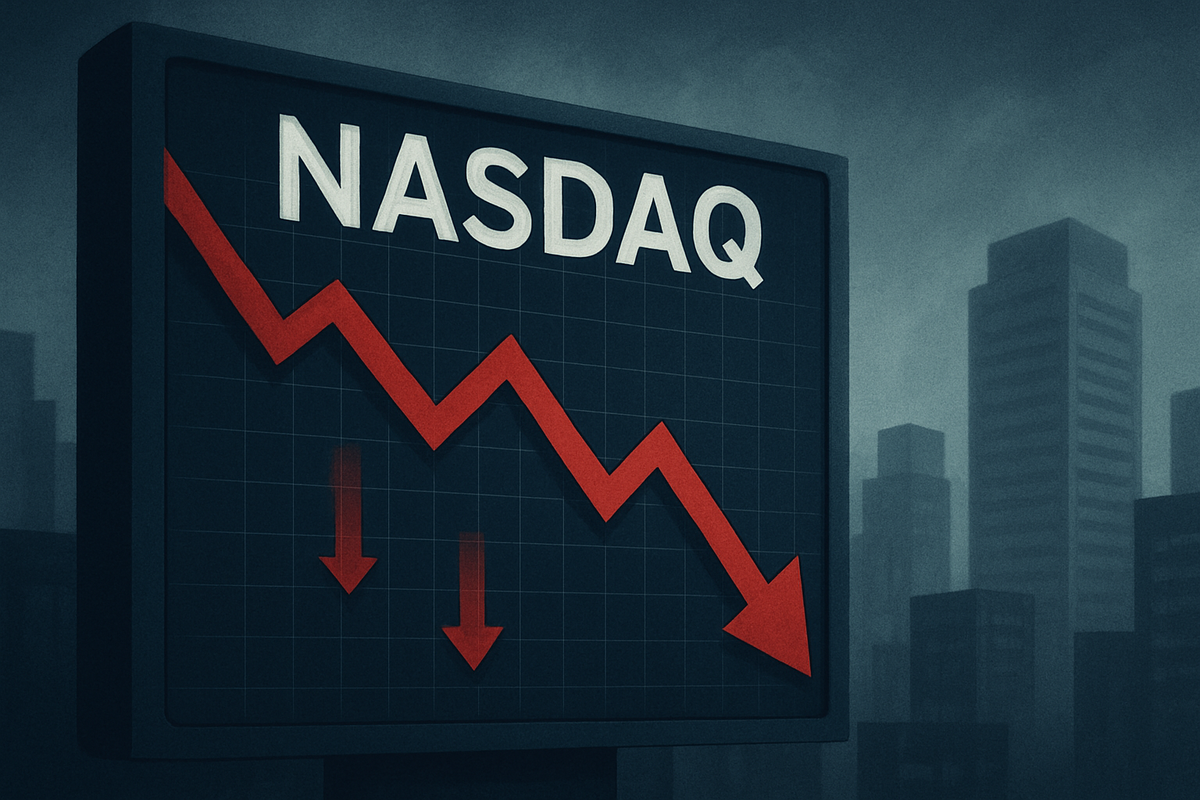
The technology-heavy Nasdaq Composite (NASDAQ: COMP) has just concluded its most challenging week since early April, signaling a significant downturn in the tech sector and sending ripples of concern throughout the broader financial markets. The first week of November 2025 saw a sharp selloff, particularly in high-flying technology and artificial intelligence (AI) stocks, as investors grappled with anxieties over inflated valuations, a deteriorating labor market, and persistent economic uncertainty. This pronounced slump underscores a growing cautiousness among market participants, prompting a critical reevaluation of growth prospects in an increasingly volatile landscape.
The downturn has been swift and impactful, with the Nasdaq Composite registering a weekly decline of 2.8%, its most substantial drop in seven months. This performance has not only erased recent gains but has also sparked fears of a more prolonged correction in a sector that has largely driven market momentum for much of the year. The immediate implications point to a cooling of investor enthusiasm for previously robust tech and AI narratives, suggesting a shift towards more fundamental-driven assessments rather than speculative growth.
A Week of Reckoning: Unpacking Nasdaq's November Selloff
The first week of November 2025 proved to be a crucible for the tech sector, culminating in the Nasdaq Composite's most significant weekly retreat since April. On November 7th alone, the index tumbled 1.9%, following a 2% drop on November 5th, closing the week down a total of 2.8%. This sharp decline was mirrored by the Nasdaq 100 (NASDAQ: NDX), which also recorded its steepest weekly fall since early April, while the broader S&P 500 (NYSEARCA: SPY) technology index shed 2%, and the Philadelphia SE Semiconductor Index (SOX) was down 2.4%. The Cboe Volatility Index (VIX), often seen as the market's "fear gauge," surged 8.3% to 19.50, reflecting a palpable increase in investor apprehension.
Several converging factors fueled this selloff. A primary catalyst was the growing sentiment that many AI and technology stocks had reached "overstretched" and "lofty" valuations, prompting widespread profit-taking. Warnings from major investment banks about a potential significant market correction had been circulating, and this week's events appeared to validate those concerns. Simultaneously, alarming labor market data revealed over 153,000 U.S. job cuts in October, nearly triple September's figures and the highest for the month in 22 years, making 2025 the worst year for layoffs since 2009. The technology sector bore a significant brunt, shedding 33,281 jobs in October, partly attributed to AI integration and restructuring efforts. This weakening labor market intensified expectations for further interest rate cuts by the Federal Reserve (FED).
Compounding these issues was the ongoing U.S. government shutdown, which had become the longest in history. This shutdown severely limited the availability of official economic data, forcing investors to rely on private reports and increasing market susceptibility to volatility. Disappointing corporate earnings and cautious forecasts from several key players further exacerbated the negative sentiment. For instance, Qualcomm (NASDAQ: QCOM) shares declined due to warnings about potential future business losses with Apple (NASDAQ: AAPL), despite reporting strong quarterly results. Other prominent tech firms like Advanced Micro Devices (NASDAQ: AMD), Palantir (NYSE: PLTR), Oracle (NYSE: ORCL), Meta Platforms (NASDAQ: META), Block (NYSE: SQ), Take-Two Interactive (NASDAQ: TTWO), and Constellation Energy Corp (NASDAQ: CEG) also experienced declines following their respective earnings reports or conservative outlooks, highlighting a broad-based unease across the sector. The "Magnificent Seven," a group of influential AI-related megacap tech stocks, saw six of its members register losses, with an index tracking them down nearly 2% by week's end, underscoring the widespread nature of the tech rout.
Navigating the Storm: Winners and Losers in the Tech Downturn
The recent tech downturn, epitomized by Nasdaq's challenging week, is poised to create a distinct cleavage between companies that can weather the storm and those that may struggle, fundamentally reshaping competitive landscapes and investor appetites. The prevailing "risk-off" sentiment and renewed scrutiny of valuations will undoubtedly differentiate the strong from the weak.
Potential Losers: Companies with high valuations and limited immediate profitability, particularly those heavily reliant on future growth projections in the AI and speculative tech space, are likely to suffer the most. Firms like Palantir (NYSE: PLTR), which experienced declines this past week, or other AI infrastructure developers that have seen their stock prices surge based on future potential rather than current robust earnings, could face continued pressure as investors prioritize tangible financial performance. Similarly, companies with significant exposure to a weakening consumer or enterprise spending environment, especially those in the ad-tech or discretionary tech sectors, may see their revenue growth decelerate. Companies undergoing major restructuring due to AI integration and consequently implementing significant job cuts, as seen in the broader tech sector, might also face short-term operational hurdles and investor skepticism regarding their transition strategies. The impact on companies like Qualcomm (NASDAQ: QCOM), facing potential business losses from key partners like Apple (NASDAQ: AAPL), demonstrates how even established players can be vulnerable to shifts in strategic relationships amidst a cautious market.
Potential Winners: Conversely, companies with strong balance sheets, consistent profitability, and established market positions may emerge relatively unscathed or even benefit from the downturn as investors seek safe havens. Value-oriented tech companies or those providing essential, non-discretionary services could see increased interest. Firms that can demonstrate efficient operations and a clear path to profitability in their AI initiatives, rather than purely speculative growth, might also attract capital. Furthermore, companies that are less exposed to the immediate whims of the broader tech market, perhaps those in niche B2B software or cybersecurity with recurring revenue models, could prove more resilient. In a downturn, companies with strong cash flows might also find opportunities to acquire struggling competitors or talent at more favorable valuations, positioning themselves for future growth when market sentiment improves. While specific "winners" are harder to pinpoint in a broad downturn, firms like Microsoft (NASDAQ: MSFT) and Apple (NASDAQ: AAPL), despite some short-term dips, often possess the financial fortitude and diversified revenue streams to weather market volatility better than smaller, less established tech players.
The overall effect will be a heightened focus on fundamentals, profitability, and sustainable growth, pushing companies to adapt their strategies and potentially accelerate their paths to self-sufficiency. This period of market correction could serve as a necessary cleansing, weeding out unsustainable business models and rewarding those built on solid financial foundations.
Broader Implications: A Shifting Tech Landscape
Nasdaq's recent downturn is not an isolated event but rather a significant indicator of broader shifts within the technology industry and the wider economy. This correction signals a crucial maturation phase for the AI sector and a recalibration of investor expectations, moving from speculative fervor to a demand for tangible financial fundamentals.
This event fits squarely into a trend of increased scrutiny on tech valuations. For much of 2024 and early 2025, many tech and AI companies traded at premium valuations, often based on future growth potential rather than current profitability. The current selloff suggests that the market's patience for "growth at all costs" is waning, replaced by a demand for clear profitability pathways and sustainable business models. This could lead to a more disciplined approach to capital allocation within the industry, potentially slowing down some of the more speculative ventures.
The ripple effects on competitors and partners are substantial. Companies heavily reliant on venture capital funding or those with less diversified revenue streams may find it harder to secure financing or maintain growth trajectories. Larger, more established tech giants, while not immune to declines, often possess the financial resilience to absorb short-term shocks and even capitalize on opportunities, such as acquiring struggling startups at reduced valuations. The interconnectedness of the tech ecosystem means that a slowdown in one area, such as semiconductor demand from AI companies, can quickly affect suppliers and manufacturers across the globe.
From a regulatory and policy perspective, the downturn, especially if prolonged, could intensify calls for greater oversight of the tech sector, particularly concerning anti-trust issues and market dominance. A weakening tech sector might also put pressure on governments to implement policies that stimulate innovation and investment, potentially through tax incentives or relaxed regulations, to prevent a more severe economic contraction. The ongoing U.S. government shutdown, which exacerbated market uncertainty, highlights how political instability can directly impact market confidence and economic stability.
Historically, periods of rapid technological advancement followed by market corrections are not uncommon. Comparisons can be drawn to the Dot-Com bust of 2000-2001, where overinflated valuations of internet companies led to a significant market crash. While the current situation differs in its underlying technological drivers (AI vs. early internet), the core principle of speculative bubbles bursting due to unsustainable valuations remains a potent historical precedent. Similarly, the financial crisis of 2008 demonstrated how interconnected markets can quickly spread a "risk-off" sentiment globally. The current downturn, while not as severe as these historical events, serves as a stark reminder of market cyclicality and the importance of fundamental analysis. The significant job cuts in the tech sector, partly driven by AI integration, also echo historical periods of technological disruption leading to labor market adjustments, albeit with the promise of new job creation in emerging fields.
The Road Ahead: Navigating Uncertainty and Opportunity
The aftermath of Nasdaq's significant downturn presents a complex landscape of short-term challenges and long-term strategic re-evaluations for the tech sector and investors alike. The immediate future will likely be characterized by continued volatility and a heightened focus on corporate fundamentals, while the long-term trajectory will depend on how companies adapt and how broader economic conditions evolve.
In the short-term, we can expect continued profit-taking and cautious investment, especially in highly valued AI and growth stocks. Companies that recently reported disappointing earnings or gave conservative outlooks may face further pressure. Investors will be keenly watching upcoming economic data, particularly labor market reports and inflation figures, for signs of stability or further deterioration. The resolution of the U.S. government shutdown will also be a critical factor in restoring market confidence and providing a clearer economic picture. Strategic pivots will be essential for many tech firms, potentially involving a shift from aggressive expansion to cost-cutting, optimizing operational efficiencies, and accelerating paths to profitability. This could mean a slowdown in hiring, further job cuts, and a re-prioritization of product roadmaps.
Long-term possibilities include a healthier, more sustainable tech market. The current correction, while painful, could cleanse the market of overvalued, unprofitable ventures, paving the way for more robust growth driven by genuinely innovative and financially sound companies. The AI revolution is far from over; instead, it is entering a more mature phase where practical applications and tangible returns will be prioritized over hype. This could lead to a consolidation within the AI industry, with stronger players acquiring weaker ones. Market opportunities may emerge for investors willing to identify fundamentally strong companies that have been unfairly penalized by the broad selloff. Value investors might find attractive entry points in quality tech stocks that are temporarily depressed. Challenges will include navigating ongoing macroeconomic uncertainties, potential regulatory headwinds, and increased competition in a more discerning market.
Potential scenarios and outcomes vary. A "soft landing" scenario could see the market stabilize as economic data improves and the Federal Reserve potentially implements interest rate cuts, leading to a gradual recovery in tech stocks. Conversely, a "hard landing" could involve a more severe economic recession, further depressing tech valuations and leading to a prolonged downturn. Another scenario involves a "two-speed market," where established, profitable tech giants continue to perform relatively well, while smaller, less profitable growth stocks struggle to regain their footing. The key will be companies' abilities to demonstrate resilience, innovate efficiently, and adapt to a landscape that demands greater financial discipline and a clear value proposition.
Wrap-Up: A New Era for Tech Investing
Nasdaq's recent decline, marking its worst weekly performance since April, serves as a pivotal moment for the technology sector and a potent reminder of market cyclicality. The confluence of overstretched valuations in AI and tech stocks, a deteriorating labor market, ongoing economic uncertainty, and a prolonged government shutdown created a perfect storm that triggered widespread profit-taking and a significant "risk-off" sentiment. This period of correction underscores a fundamental shift in investor expectations, moving away from unbridled speculative growth towards a demand for demonstrable profitability and sustainable business models.
The key takeaway from this event is the re-emphasis on fundamentals. Companies that possess strong balance sheets, consistent earnings, and clear pathways to profitability are better positioned to weather such storms. The "crucial maturation phase" for the AI industry means that while the technology's long-term potential remains immense, the market will now be more discerning, rewarding practical applications and tangible returns over speculative hype. This will likely lead to a more disciplined and efficient allocation of capital within the tech ecosystem.
Looking forward, the market is poised for continued vigilance. Investors should watch for several key indicators in the coming months: further economic data, particularly employment figures and inflation trends, which will influence the Federal Reserve's monetary policy decisions. The resolution of political uncertainties, such as the U.S. government shutdown, will also play a crucial role in stabilizing market sentiment. Furthermore, close attention should be paid to corporate earnings reports for insights into companies' resilience and their strategies for navigating a more challenging economic environment. The performance of the "Magnificent Seven" and other bellwether tech stocks will continue to serve as a barometer for the broader sector.
This downturn, while painful in the short term, could ultimately lead to a healthier and more sustainable tech market. It forces companies to adapt, innovate with greater efficiency, and focus on creating genuine, long-term value. For investors, it presents both challenges and opportunities, demanding a more strategic and fundamentally-driven approach to tech investing in what promises to be an intriguing period of market evolution.
This content is intended for informational purposes only and is not financial advice








